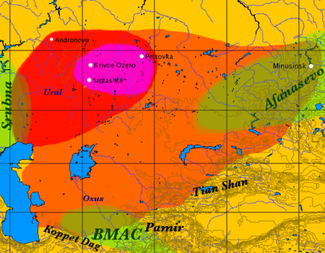| Revision as of 20:24, 13 September 2005 editDbachmann (talk | contribs)227,714 editsNo edit summary← Previous edit | Revision as of 20:41, 13 September 2005 edit undoDbachmann (talk | contribs)227,714 editsNo edit summaryNext edit → | ||
| Line 8: | Line 8: | ||
| **the nearby ] settlement dated to the 17th century; | **the nearby ] settlement dated to the 17th century; | ||
| *'''Alakul''' (2100-1400 BC) between ] and ], ]; | *'''Alakul''' (2100-1400 BC) between ] and ], ]; | ||
| *'''Fedorovo''' (1400-1200 BC) in southern |
*'''Fedorovo''' (1400-1200 BC) in southern Sibiria; | ||
| *'''Alekseyevka''' (1200-1000 BC) in eastern Kazakhstan. | *'''Alekseyevka''' (1200-1000 BC) in eastern Kazakhstan. | ||
Revision as of 20:41, 13 September 2005

The Andronovo culture is a cover term for a group of Bronze Age cultures of southern Siberia and Central Asia, ca. 2300 BC–1000 BC. It is probably better termed an archaeological complex or archaeological horizon. The name derives from the village of Andronovo (55°53′N 55°42′E / 55.883°N 55.700°E / 55.883; 55.700), where in 1914, several graves were discovered, with skeletons in crouched positions, buried with richly decorated pottery.
At least four sub-cultures have been since distinguished, during which the culture expands towards the south and the east:
- Sintashta-Petrovka-Arkaim (Southern Urals, northern Kazakhstan, 2200-1600 BC),
- the Sintashta fortification of ca. 1800 BC at the Chelyabinsk Oblast;
- the nearby Arkaim settlement dated to the 17th century;
- Alakul (2100-1400 BC) between Oxus and Jaxartes, Kyzylkum desert;
- Fedorovo (1400-1200 BC) in southern Sibiria;
- Alekseyevka (1200-1000 BC) in eastern Kazakhstan.
The geographical extent of the culture is vast, and difficult to delineate exactly. On its western fringes, it overlaps with the approximately contemporaneous (but distinct) Srubna culture in the Volga-Ural interfluvial; to the east it reaches into the Minusinsk depression, overlapping with the area of the earlier Afanasevo culture; additional sites are scattered as far south as the Koppet Dag (Turkmenistan), the Pamir (Tajikistan) and the Tian Shan (Kyrgyzstan). The northern boundary vaguely corresponds to the beginning the Taiga. In the Volga basin, interaction with the Srubna culture was most intensed and prolongued, and Federovo style pottery is found as far west as Volgograd.
Towards the middle of the 2nd millennium, the Andronovo cultures begin to move intensively eastwards.
They mined deposits of copper ore in the Altai Mountains and lived in villages of as many as ten sunken log cabin houses measuring up to 30m by 60m in size. Burials were made in stone cists or stone enclosures with buried timber chambers.
In other regards, the economy was both pastoral, based on horses and cattle, but also sheep and goats, and agricultural.
The Andronovo culture has been strongly associated with early Indo-Iranian culture. In particular, it is credited with the invention of the spoke-wheeled chariot around 2000 BC; Di Cosmo (p. 903) referring to finds related to the Andronovo culture from "as early as 2026 B.C."
Sintashta is a site on the upper Ural River. It is famed for its grave-offerings, particularly chariot burials. These inhumations were in kurgans and included all or parts of animals (horse and dog) deposited into the barrow. Sintashta is often pointed to as the premier proto-Indo-Iranian site, and that the language spoken was still in the Proto-Indo-Iranian stage. There are similar sites "in the Volga-Ural steppe" (Mallory).
Successors
The Sintashta-Petrovka culture is succeeded by the Fedorovo (1400-1200 BC) and Alekseyevka (1200-1000 BC) cultures, still considered as part of the Andronovo horizon.
In southern Siberia and Kazakhstan, the Andronovo culture was succeeded by the Karasuk culture (1500-800 BC), which is sometimes asserted to be non-Indo-European, and at other times to be specifically proto-Iranian. On its western border, it is succeeded by the Srubna culture, which partly derives from the Abashevo culture. The earliest historical peoples associated with the area are the Cimmerians and Saka/Scythians, appearing in Assyrian records after the decline of the Alekseyevka culture, migrating into the Ukraine from ca. the 9th century BC (see also Ukrainian stone stela), and across the Caucasus into Anatolia and Assyria in the late 8th century BC, and possibly also west into Europe as the Thracians (see Thraco-Cimmerian), and the Sigynnae, located by Herodotus beyond the Danube, north of the Thracians, and by Strabo near the Caspian. Both Herodotus and Strabo identify them as Iranian.
References
- "The Northern Frontier in Pre-Imperial China", Cambridge History of Ancient China (pp. 885-966) ch. 13, Nicolo Di Cosmo.
- James P. Mallory, "Andronovo Culture", Encyclopedia of Indo-European Culture, Fitzroy Dearborn, 1997.
See also
External link
- Center for the Study of Eurasian Nomads (csen.org)
- The Discovery of Sintashta (a Russian-language article by two archaeologists who directed the excavations)
- ARCHAIC MOTIFS IN NORTH RUSSIAN FOLK EMBROIDERY AND PARALLELS IN ANCIENT ORNAMENTAL DESIGNS OF THE EURASIAN STEPPE PEOPLES S. Zharnikova